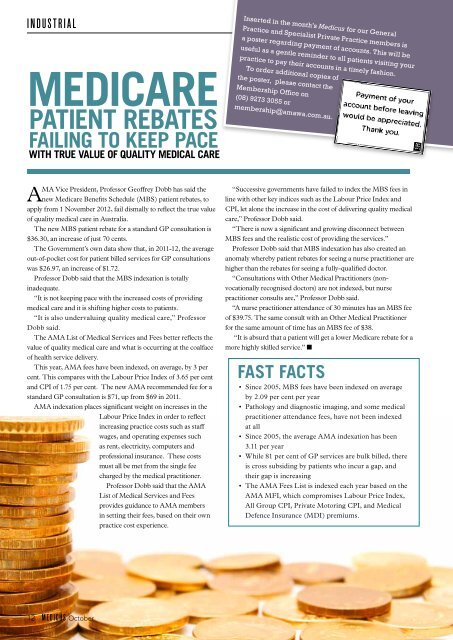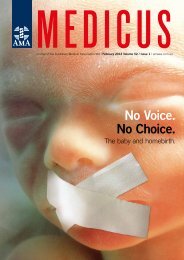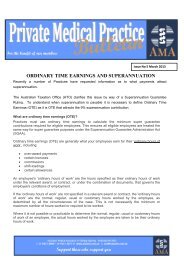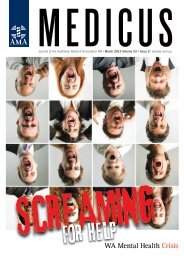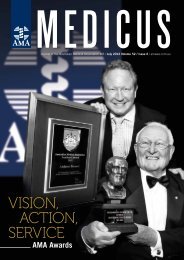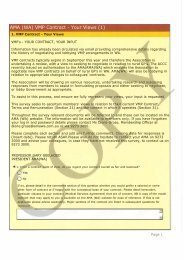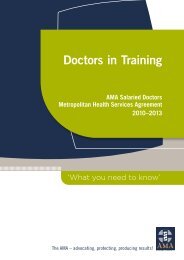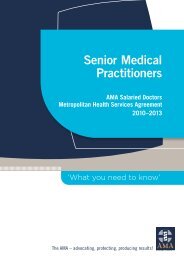twrama 1990_final oc.. - AMA WA
twrama 1990_final oc.. - AMA WA
twrama 1990_final oc.. - AMA WA
You also want an ePaper? Increase the reach of your titles
YUMPU automatically turns print PDFs into web optimized ePapers that Google loves.
INDUSTRIAL<br />
MEDICARE<br />
PATIENT REBATES<br />
FAILING TO KEEP PACE<br />
WITH TRUE VALUE OF QUALITY MEDICAL CARE<br />
Inserted in the month’s Medicus for our General<br />
Practice and Specialist Private Practice members is<br />
a poster regarding payment of accounts. This will be<br />
useful as a gentle reminder to all patients visiting your<br />
practice to pay their accounts in a timely fashion.<br />
To order additional copies of<br />
the poster, please contact the<br />
Membership Office on<br />
(08) 9273 3055 or<br />
membership@amawa.com.au.<br />
<strong>AMA</strong> Vice President, Professor Geoffrey Dobb has said the<br />
new Medicare Benefits Schedule (MBS) patient rebates, to<br />
apply from 1 November 2012, fail dismally to reflect the true value<br />
of quality medical care in Australia.<br />
The new MBS patient rebate for a standard GP consultation is<br />
$36.30, an increase of just 70 cents.<br />
The Government’s own data show that, in 2011-12, the average<br />
out-of-p<strong>oc</strong>ket cost for patient billed services for GP consultations<br />
was $26.97, an increase of $1.72.<br />
Professor Dobb said that the MBS indexation is totally<br />
inadequate.<br />
“It is not keeping pace with the increased costs of providing<br />
medical care and it is shifting higher costs to patients.<br />
“It is also undervaluing quality medical care,” Professor<br />
Dobb said.<br />
The <strong>AMA</strong> List of Medical Services and Fees better reflects the<br />
value of quality medical care and what is <strong>oc</strong>curring at the coalface<br />
of health service delivery.<br />
This year, <strong>AMA</strong> fees have been indexed, on average, by 3 per<br />
cent. This compares with the Labour Price Index of 3.65 per cent<br />
and CPI of 1.75 per cent. The new <strong>AMA</strong> recommended fee for a<br />
standard GP consultation is $71, up from $69 in 2011.<br />
<strong>AMA</strong> indexation places significant weight on increases in the<br />
Labour Price Index in order to reflect<br />
increasing practice costs such as staff<br />
wages, and operating expenses such<br />
as rent, electricity, computers and<br />
professional insurance. These costs<br />
must all be met from the single fee<br />
charged by the medical practitioner.<br />
Professor Dobb said that the <strong>AMA</strong><br />
List of Medical Services and Fees<br />
provides guidance to <strong>AMA</strong> members<br />
in setting their fees, based on their own<br />
practice cost experience.<br />
“Successive governments have failed to index the MBS fees in<br />
line with other key indices such as the Labour Price Index and<br />
CPI, let alone the increase in the cost of delivering quality medical<br />
care,” Professor Dobb said.<br />
“There is now a significant and growing disconnect between<br />
MBS fees and the realistic cost of providing the services.”<br />
Professor Dobb said that MBS indexation has also created an<br />
anomaly whereby patient rebates for seeing a nurse practitioner are<br />
higher than the rebates for seeing a fully-qualified d<strong>oc</strong>tor.<br />
“Consultations with Other Medical Practitioners (nonv<strong>oc</strong>ationally<br />
recognised d<strong>oc</strong>tors) are not indexed, but nurse<br />
practitioner consults are,” Professor Dobb said.<br />
“A nurse practitioner attendance of 30 minutes has an MBS fee<br />
of $39.75. The same consult with an Other Medical Practitioner<br />
for the same amount of time has an MBS fee of $38.<br />
“It is absurd that a patient will get a lower Medicare rebate for a<br />
more highly skilled service.” ■<br />
FAST FACTS<br />
• Since 2005, MBS fees have been indexed on average<br />
by 2.09 per cent per year<br />
• Pathology and diagnostic imaging, and some medical<br />
practitioner attendance fees, have not been indexed<br />
at all<br />
• Since 2005, the average <strong>AMA</strong> indexation has been<br />
3.11 per year<br />
• While 81 per cent of GP services are bulk billed, there<br />
is cross subsiding by patients who incur a gap, and<br />
their gap is increasing<br />
• The <strong>AMA</strong> Fees List is indexed each year based on the<br />
<strong>AMA</strong> MFI, which compromises Labour Price Index,<br />
All Group CPI, Private Motoring CPI, and Medical<br />
Defence Insurance (MDI) premiums.<br />
12 MEDICUS October


